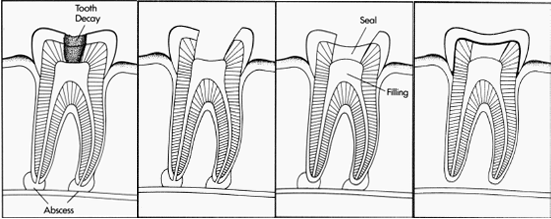Root Canals
Infections within the nerve chamber of the tooth due to decay may require a root canal to prevent removal of the tooth.
Each tooth features an outer shell that houses a nourishing pulp consisting of lymph vessels, nerves and blood vessels. The root canal, which is the chamber in which the pulp is stored, extends into the bone.
Diagram of a healthy tooth.

What Is a Root Canal Treatment?
Your dentist uses root canal treatment to find the cause and then treat problems of the tooth’s soft core (the dental pulp). Years ago, teeth with diseased or injured pulps were removed. Today, root canal treatment has given dentists a safe way of saving teeth.
Signs You Need Treatment
An injury or deep tooth decay is likely to cause an infection and serious damage to nerves and vessels in the pulp. In these situations, a root canal treatment can clean out the chamber and repair any damage.
Some signs may include:
— Throbbing or spontaneous pain when biting down
— Sensitivity to cold or hot food
— Severe decay or injury that causes an infection in the bone

What Happens If Pulp Is Injured?
If the pulp is injured or diseased, it won’t self-heal; it will die off. This is typically caused by a crack in the tooth or a cavity that runs deep. This allows bacteria into the pulp of the tooth, which can cause infection. If left untreated, pus can build up at the root tip, down to the jaw bone, creating an abscess. This leads to more damage in the bone surrounding the teeth.
Why Should It Be Removed?
If infected pulp isn’t removed, you may experience swelling and pain. This can also injure your jaw bones. You may also need to remove the tooth completely.
What Does Root Canal Treatment Involve?
Root canal treatment is performed in one, two or three visits. During the visits, the dentist will remove the pulp and clean and seal the chamber.
How the Treatment Works
The dentist first creates an opening from the exterior into the pulp chamber. The pulp is removed through the opening and the root canal is cleaned and shaped to accept the filling. Medication is applied to the pulp chamber to eliminate germs and prevent further infection. A temporary filling is then placed in the opening to seal it if additional visits are necessary. In some cases, the tooth may be left open to drain for several days. When the temporary filling is removed, the pulp chamber is cleaned one last time and filled. A gold or porcelain crown is then placed over the tooth to restore its function.
How Long Will It Last?
For many patients, a restored tooth can last a lifetime if properly cared for. However, it’s essential to continue regular checkups. As long as the tissues surrounding the tooth are healthy and nourishing, the tooth will be healthy.
